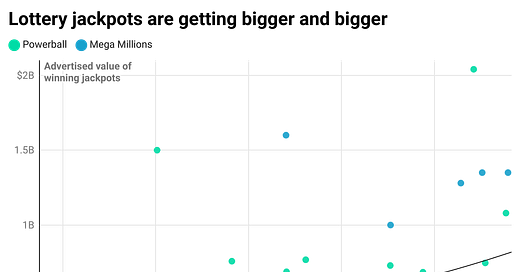Zach Seward (ZS) is a journalist and media entrepreneur who co-founded the business news organization Quartz, where he worked until earlier this year. Now he’s blogging at zachseward.com while figuring out what’s next.
Zach here. Lotteries are obviously a scam, but did you know the scam is getting worse?
The jackpot for tomorrow’s Mega Millions drawing is advertised at $1.55 billion. Just last month, Powerball's top prize also hit 10 figures. Indeed, huge jackpots are increasingly common in the two major American lotteries:
This is not happening by chance. One factor is that players face longer odds of winning it all. In 2015, Powerball added 10 white ping-pong balls to its drawings, which made smaller prizes, for matching just a few numbers, easier to win, but the jackpot more elusive. Mega Millions did the same thing in 2017.
The other reason is that lotteries inflate the value of their jackpots, and current economic conditions are compounding the lie.
WITI Classifieds:
We are experimenting with running some weekly classifieds in WITI. If you’re interested in running an ad, you can purchase one through this form. If you have any questions, don’t hesitate to drop a line.
Interpreting the internet for the tasteful reader. Join 23,000+ subscribers who rely on Dirt for their cultural alpha. Subscribe for free.
Why is this interesting?
You probably know that lottery jackpots are expressed two ways: the "cash value" and "advertised value." The cash value is based on revenue from ticket sales, after retailers and state lottery groups take their cut and other prizes are doled out. If nobody hits the jackpot, the prize pool carries over to the next drawing. In other words, the cash value is the actual amount of money waiting in the pot.
Advertised values, on the other hand, are projections of how much money the winner could accumulate by allowing the lottery to conservatively invest the cash jackpot and pay out a little at a time, otherwise known as an annuity. The specific investment strategy employed by Powerball and Mega Millions is to purchase long-term, zero-coupon bonds from the U.S. government. Treasury yields have been going up, which makes the annuity a better investment than it used to be. As a result, advertised jackpots are now running at roughly twice their cash value:
The cash value is often presented as a "lump-sum option" for those impatient to collect their winnings at a discount. But it's the opposite: The lump sum is all there is, and the additional funds that get you to the advertised value are generated by investing the money, which the winner could do on their own.
Of course, the advertised value is what gets, well, advertised—by the lotteries themselves and in frenzied media coverage whenever the number grows large enough. Huge jackpots are the lifeblood of any lottery, dangling unimaginably large sums in the face of vanishingly small odds. They keep regular players chasing an impossible dream and the broader public interested in lotteries, too.
This is a pretty grumpy take on my part, I know. But lotteries prey on the poor, and the hoopla around billion-dollar jackpots abets these state-sponsored scams. (ZS)
—
Thanks for reading,
Noah (NRB) & Colin (CJN) & Zach (ZS)
—
Why is this interesting? is a daily email from Noah Brier & Colin Nagy (and friends!) about interesting things. If you’ve enjoyed this edition, please consider forwarding it to a friend. If you’re reading it for the first time, consider subscribing.







Another example of US taking scamming to a new level. Just checked euromillions and 20mil means 20mil, lump sum, no annuity and in some countries no taxes.
I think you are splitting hairs regarding the net present value (cash value) and the annuity payout (advertised value). However what you haven't included are the tax consequences. Winning will be considered ordinary income by Federal and State (if applicable). That brings the NPV of winning to about the 1/3 of the advertised value or less.
TBH, seems that the "advertised value" is the wisest choice for people who are financially inexperienced with large amounts of money especially in today's interest rate environment